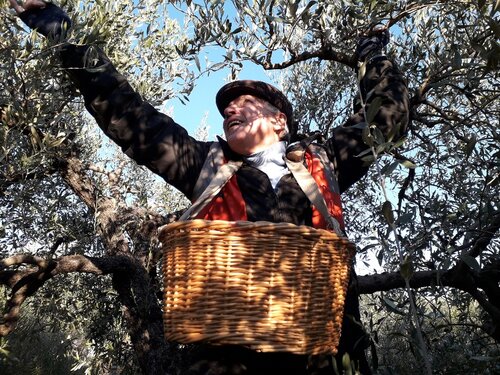Extra virgin olive oil from Nyons is extracted from the Tanche olive and produced by cold pressing.
Olive oil is part of our history and constitutes world cultural heritage. In 2010 UNESCO inscribed the Mediterranean diet , notably olive oil, cereals and fish, in the list of intangible cultural heritage. Several olive-growing areas have become UNESCO world heritage sites, including the orchards of Andalusia and the Battir groves in Palestine. Currently UNESCO considers the inscription of millennium-old olive groves in Catalonia, Puglia, Croatia and Montenegro.
Native to the Mediterranean basin, the olive tree was cultivated already by Mesolithic societies 8000-10,000 years ago, as documented by archaeological finds throughout Europe, e.g. in 1940 an oil lamp made of stone was found in the Lascaux caves of France. Olive oil fuelled not only lamps, but gave rise to industry and art – lamps made of alabaster, shell, bronze, iron and, of course, the cheaper red pottery lamp (there are thousands of them in museums throughout the world, dating back to the Chalcolithic age).
As we know from Greek mythology, the origin of the olive tree was a contest between Athena, Goddess of Wisdom, and Poseidon, God of the Sea, as to who would become the protector of the city to be built in Attica, which would be named after the divinity who gave the people the most precious gift. With his trident, Poseidon struck a rock from which water rushed out. Athena followed by striking another rock with her spear and producing the olive tree, lauded for its wood and fruit that rendered food, fuel, and shade. Not far from the Parthenon on the Acropolis rises Athena’s tree spends tourists its shade.
Trade in olive oil expanded from Greece, Crete, Naxos, Cyprus, Syria, Egypt and Rome and found uses in the manufacture of soaps, cosmetics and perfumes. Olympic athletes oiled themselves regularly for purposes of cleansing and moisturizing, as did women concerned with beauty and skin care.
The origin of the olive tree was a contest between Athena, Goddess of Wisdom, and Poseidon, God of the Sea.
Olive oil plays a role in rituals described in both the Old and New Testaments and is used in the Christian rites of Baptism, Confirmation, the ordination of priests, bishops and Popes, and for anointing the sick. Kings and Emperors have been daubed with oil, from Saul and David, to Justinian, Charlemagne, Saint Louis IX, Charles V of Habsburg, and Elisabeth II of England.
French olive oil is high quality, gourmet food. My favourite is the Nyons AOC produced in old traditional mills from the wrinkled black Tanche olive, which has a unique aroma and hazelnut/almond flavour. This December, for the fifth time, my wife Carla and I travelled to Piégon, just outside Nyons, to Swiss friends who own a large recreational orchard. Harvesting olives by hand – one by one — is hard work – but lots of fun. The harvest of the ripe olive takes place end December/beginning January. The biggest olives are selected by hand to be put in the salt brine for six weeks. After curing, the olives can be spiced with garlic, rosemary, thyme etc.



